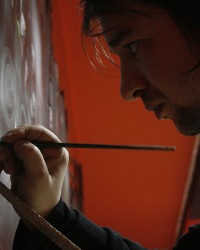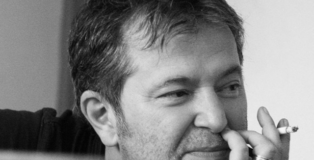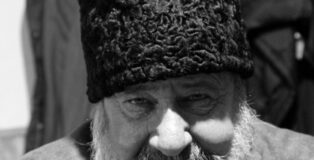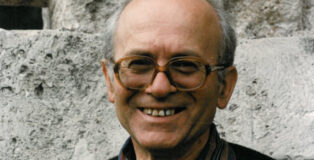Zbârnea Tudor
[:ro]
Prezentare Demers Artistic
Tudor Zbârnea face parte din specia celor care cercetează prin artă sfera esteticului şi a eticului, a esteticului împletit organic cu eticul în spiritul conceptului grec de Kalokagathon.Concept şi ideal propus ca ideal şi pentru omul modern care prea adesea a ignorat sau respins ideea de frumos în „favoarea” celei de expresiv sau chiar de urât.
Kalookagathos, kalos kai agathos – Frumosul este Bine sau, altfel spus, Binele este Frumos. Este frumuseţe.
Tudor Zbârnea face parte din specia moraliştilor, a celor ce meditează asupra condiţiei umane, dar o face strict cu mijloacele artei, o face din interiorul imperativelor imaginii şi nu ca discurs supraadăugat imaginii.
Tensiunile expresioniste din unele din picturile sale sunt expresia meditaţiei sale asupra omului în lume, a omului de azi în chip special. Meditaţie împletită intim cu cea asupra naturii picturii.
Putem spune, parafrazând, că expresionismul lui este unul „bine temperat”. Artistul nu uzează de mari distorsiuni ale formei, de mari contraste de culori sau de valori. Pictura lui nu atinge niciodată grotescul, strigătul disperat, gesticulaţia lipsei de speranţă. Cromatica sa este gravă dar nu sumbră. Pictura se aşază pe planul pânzei ca pe un zid, ca pe un zid de mănăstire. Dar să ne amintim că în iconografia religioasă este figurat şi iadul. Ca şi Judecata din Urmă, perspectiva Învierii, Deisis.
În subtextul imaginilor sale putem ghici uneori tiparul icoanei ca formă spiritualizată de organizare a imaginii date şi elementaritatea unor configurări arhaice (seria de imagini totemice cu idoli) când pictura devine mai aspră, mai frustă.
Tudor Zbârnea este un neliniştit al căutării de sine, al căutării adevărului, un ochi acut îndreptat spre înţelesurile morale ale vieţii („Dezintegrare”,”Utopia veşniciei sau adevărul clipei”,”Reîntoarcerea spre sine”). În acelaşi timp este un pasionat cercetător al resurselor expresive ale imaginii ce se desfăşoară în vastul spaţiu dintre expresionism şi abstracţia cu tentă simbolică.
A început să se vorbească despre „cel de al doilea modernism”, care spre deosebire de primul nu mai proclamă „autonomia absolută a imaginii”, imaginea ce-şi află scopul ultim în sine, în propria configuraţie, ci este preocupat de inserţia imaginii în marea semantică a lumii, a vieţii.
În acest sens, Tudor Zbârnea aparţine „celui de al doilea modernism”.
Sept. 2010 Marin Gherasim
website link: www.zbarnea.arta.md, ,
www.tudorzbarnea.com
[:en]
Prezentare Demers Artistic
Tudor Zbarnea makes part from that category of painters who examine by means of art the aesthetics and ethics, the aesthetics organically interweaved with the ethics in accordance with the Greek concept Kalokagathon. A concept and ideal suggested also as an ideal for the modern human being who has been frequently ignoring or rejecting the idea of beautifulness in “favor” of expressiveness or even ugliness.
Kalookagathos, kalos kai agathos – Beautifulness is Goodness or, in other words, Goodness is Beautiful. It is beauty.
Tudor Zbarnea is one of those moralists, who are meditating on the human being condition, but he makes it strictly through artistic means, he makes it from within the imperatives of the image and not as an additional speech to the image.
Expressionist tensions from some of his paintings are the expression of his meditation on the human being in the world, especially of the present day human being. This meditation is intimately blend with the one focused on the nature of the painting.
In other words, we may say that his expressionism is one “well tempered”. The artist does not use great distortions of the form, great contrasts of colors or values. His painting is never grotesque, never desperately crying, never gesticulating because of lack of hope. His chromatics is severe but not somber. The painting is laid on the canvas like on a wall, monastery wall. But let us remember that in the religious iconography the hell is also present. As well as Last Judgement, the possibility of Resurrection, Deisis.
In the subtext of his images we may guess sometimes the pattern of the icon as a spiritualized form of organization of the image and the elementary notion of the archaic configuration (the series of totemic images with idols) when the painting becomes more stern, rougher.
Tudor Zbarnea is in an anxious search of himself, of the truth. His eye is keenly directed towards the moral sense of the life (“Disintegration”, “The utopia of the eternity or the truth of the moment”, “Returning to himself”). At the same time he is a passionate investigator of the expressive resources of the image that take place in the huge space between expressionism and abstraction with symbolic flavor.
“The second modernism” has begun to be talked about. In comparison with the first, it is not proclaiming anymore “the absolute autonomy of the image”, the image that finds its ultimate scope in itself, in its own configuration but it is concerned by the insertion of the image in the immense matter of the world, of the life.
In this respect, Tudor Zbarnea belongs to “the second modernism”.
September 2010 Marin Gherasim
website link: www.zbarnea.arta.md, ,
www.tudorzbarnea.com
[:]

















Comentarii recente